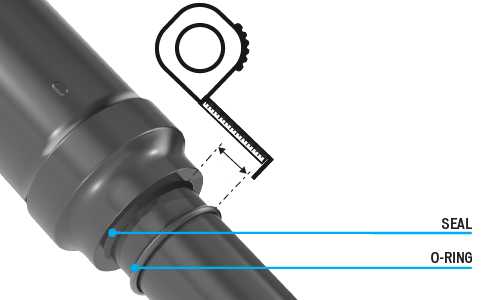Adjust Your Bike Fit and Suspension
Ensuring that your bike is properly fit to you is an important step in preparing for your first ride. Your Authorized Specialized Retailer will be able to provide a basic fit so that you are able to ride comfortably and efficiently. Specialized also offers Retül Fit, a data-driven bicycle fitting tool designed to improve comfort, prevent injury, and increase performance.
Sizing
| S | M | L | XL | |
| Rider height | 155 - 165 cm 5'1" - 5'4" | 165 - 178 cm 5'4" - 5'8" | 175 - 185 cm 5'7" - 6'1" | 185 - 195 cm 6'1" - 6'4" |
Adjust saddle height
When adjusting the saddle height or installing an aftermarket dropper post, it is important to ensure the insertion depth is within the acceptable range.
| Seat post maximum insertion | Seat post minimum insertion | |
|---|---|---|
| S | 240mm | 90mm |
| M-XL | 260mm |
All models use a 34.9mm seat post and a 38.6mm seat collar. Torque the seat post collar bolt to 6.2 Nm / 55 in-lbf.
Warning: For general instructions regarding the installation of the seat post, refer to the appropriate section in the Owner's Manual. Riding with an improperly tightened seat post can allow the saddle and seat post to slide down, which can damage the frame and cause you to lose control and fall.
Adjust the reach
If your bike is the correct size, you should be able to comfortably reach the handlebars with your elbows slightly bent. Your bike saddle can move back and forth on the rails–start with it centered and fine tune as needed. A professional bike fitter will set this position to line up your knee with the pedal axle. You can also adjust your reach by raising or lowering your handlebar height, and by increasing or decreasing the length of your bike stem.
Adjust your suspension
Your Authorized Specialized Retailer can help you set up your suspension. To do it at home, you'll need your bicycle user manual, a shock pump, all your normal riding gear, and someone to help you.
Set air shock pressure and sag
Look up the sag recommended for your frame in your user manual. For Tero X, it is 13.75 mm.
- Set your rebound and compression adjustment to the open or trail positions. Unscrew the air valve and thread a shock pump onto the air valve. Add air pressure (in psi) equal to your body weight including all riding gear.
- To check the sag, push the o-ring against the seal, then mount the bicycle while propped up against a wall. Sit in the saddle in a normal riding position, without bouncing. Do not set sag while riding!
When the pressure is correctly set, the o-ring will move about 30% of the shock stroke distance after the rider's weight has been applied to the bike with no bounce.
Add more air pressure if your sag is greater than 30%; release air pressure if your sag is less than 30%. Repeat steps 3-4 until your sag is correctly set.
To set your sag correctly, measure from the seal to the o-ring as shown in the image below, after following the above steps.

Adjust rebound
Rebound damping (usually a red knob) controls how quickly the shock returns after a compression. The rear shock has a range of rebound clicks to fine-tune the rebound return rate. See your user manual for the suggested rebound adjustment. Use the below steps as a guide.
- Start with the rebound set in the middle of the click range.
- Turn clockwise for slower rebound (heavier riders, slower speed, bigger hits).
- Turn counter-clockwise for faster rebound (lighter riders, faster speed, smaller bumps, and greater traction).
Set fork shock pressure
Most forks with an air spring have a small decal on the back of the fork’s lower leg to indicate suggested air pressure for your rider weight, including all riding gear. You can also find this information in your user manual. If you don't have this information handy, you can estimate 1/2 of your rider weight.




























































































